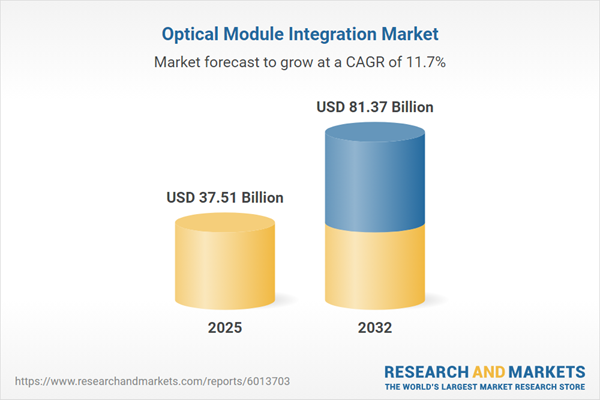Speak directly to the analyst to clarify any post sales queries you may have.
Senior executives evaluating investments in the optical module integration market face mounting pressure to adapt quickly to shifting connectivity standards, new regulations, and the transformative effects of digital modernization. A pragmatic approach is vital to maintaining operational excellence and aligning infrastructure strategies with evolving global requirements.
Market Snapshot: Optical Module Integration Market Overview
The optical module integration market is experiencing significant momentum, now standing at a value of USD 33.49 billion in 2024. Growth forecasts anticipate this market to reach USD 37.51 billion in 2025 and surge to USD 81.37 billion by 2032, representing a compound annual growth rate (CAGR) of 11.73%. This expansion is fueled by widespread digital transformation, the ongoing overhaul of telecom infrastructures, and strong demand from hyperscale cloud providers. As organizations decommission outdated systems, integrated optical modules underpin seamless transitions to new architectures, enabling efficient, scalable, and cloud-centric deployments. The relevance of this market is further strengthened by continued realignment of enterprise operational models and compliance standards worldwide.
Scope & Segmentation
- Data Rate Segments: The market offers solutions across diverse bandwidths from 10G up to 800G, supporting modernization for both established and newly built enterprise and telecom networks.
- Form Factor Options: Comprehensive product ranges encompass form factors including CFP4, OSFP, QSFP-DD, QSFP28, and SFP+. These formats are instrumental in bridging legacy projects with next-generation deployment needs and support smooth integration across varied infrastructure strategies.
- Reach Categories: Modules are available for Extended, Long, and Short Reach applications, covering connectivity from metropolitan to long-haul and edge deployments, ensuring reliable network performance in demanding contexts.
- Wavelength Classes: Integration spans both Multi Mode fibers (OM3, OM4, OM5) and Single Mode systems (CWDM, DWDM), providing versatility and compatibility to address wide-ranging operational requirements and network architectures.
- Application Verticals: Target environments include hyperscale and traditional data centers, as well as mission-critical telecom deployments, with an emphasis on supporting resilient interconnectivity and redundancy.
- Geographical Coverage: The scope includes solutions tailored for diverse regions such as the Americas, EMEA, and Asia-Pacific, addressing region-specific regulatory, compliance, and adoption challenges for seamless implementation.
- Key Company Profiles: Leading industry participants are Broadcom Inc., Lumentum Holdings, II-VI Incorporated, Accelink Technologies, Source Photonics, InnoLight Technology, Sumitomo Electric, Huawei Technologies, NeoPhotonics Corporation, and ZTE Corporation.
Key Takeaways for Senior Leaders
- Silicon photonics and coherent optics enhance modular network scalability, equipping enterprises to accommodate business growth and adapt to distributed workloads efficiently.
- Embracing open and disaggregated network models supports flexible deployment and nurtures strategic alliances, enabling organizations to remain responsive to emerging operational frameworks.
- Advanced edge requirements are prompting progress in thermal management and packaging, improving reliability of optical modules and supporting seamless certification efforts.
- Encouraging collaboration across procurement, technical, and deployment teams speeds up delivery cycles, contains operational spending, and increases solution validity.
- Region-specific strategies help enterprises maintain compliance and competitive edge, especially in landscapes like Asia-Pacific and EMEA where regulatory diversity shapes market access.
- Focusing on responsible sourcing and eco-conscious design aligns with stricter environmental regulations and corporate objectives for efficiency and accountability.
Tariff Impact: Navigating 2025 U.S. Tariffs
Imminent changes to U.S. tariffs are prompting organizations to reevaluate their sourcing strategies and supplier diversification. Senior decision-makers are proactively assessing manufacturing locations and adapting procurement frameworks, with the goal of mitigating cost volatility and safeguarding supply chain resilience. These adjustments are a direct response to evolving U.S. trade regulations affecting optical module procurement and integration decisions.
Methodology & Data Sources
This research leverages interviews with key industry stakeholders—including optical module providers, systems integrators, and compliance specialists—supported by comprehensive technical literature and regulatory analysis. Scenario-based models and cross-checking ensure reliability, delivering actionable insights for senior leaders engaged in network modernization.
Why This Report Matters
- Provides technology and procurement leaders with critical supplier benchmarks, streamlining integration and partnership decisions during periods of infrastructure change.
- Delivers actionable frameworks to manage risk, enhance sourcing efficiency, and inform forward-looking investment strategies in telecom and data center environments.
- Guides adoption of sustainable sourcing and supply management practices, aligning with escalating environmental and regulatory scrutiny in the technology sector.
Conclusion
Senior executives who lead with agility and anticipate both regulatory and technical shifts position their organizations for operational resilience and sustainable competitive advantage in the rapidly changing optical module integration market.
Additional Product Information:
- Purchase of this report includes 1 year online access with quarterly updates.
- This report can be updated on request. Please contact our Customer Experience team using the Ask a Question widget on our website.
Table of Contents
3. Executive Summary
4. Market Overview
7. Cumulative Impact of Artificial Intelligence 2025
Companies Mentioned
The companies profiled in this Optical Module Integration market report include:- Broadcom Inc.
- Lumentum Holdings, Inc.
- II-VI Incorporated
- Accelink Technologies Co., Ltd.
- Source Photonics, Inc.
- InnoLight Technology Co., Ltd.
- Sumitomo Electric Industries, Ltd.
- Huawei Technologies Co., Ltd.
- NeoPhotonics Corporation
- ZTE Corporation
Table Information
| Report Attribute | Details |
|---|---|
| No. of Pages | 194 |
| Published | November 2025 |
| Forecast Period | 2025 - 2032 |
| Estimated Market Value ( USD | $ 37.51 Billion |
| Forecasted Market Value ( USD | $ 81.37 Billion |
| Compound Annual Growth Rate | 11.7% |
| Regions Covered | Global |
| No. of Companies Mentioned | 11 |









